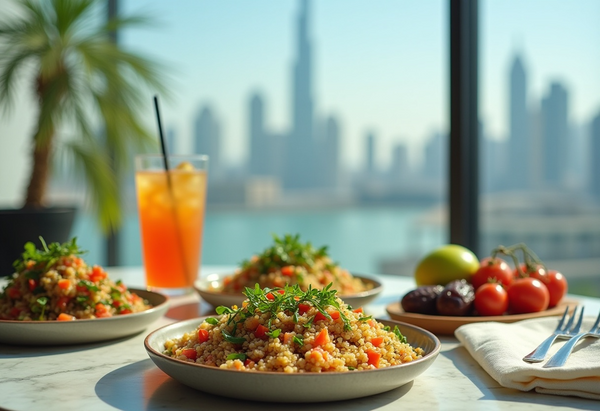Sample 7-Day Weight Loss Meal Plan for Beginners
by Justine Yolanda

Introduction
Are you ready to kickstart your weight loss journey but unsure where to begin? Meal planning is one of the most effective ways to stay on track and achieve your weight loss goals. It not only helps you manage your calorie intake but also ensures you get the necessary nutrients your body needs to function optimally.
When you plan your meals ahead of time, you gain control over your food choices, portion sizes, and the quality of ingredients. This approach prevents impulsive eating, reduces stress, and keeps your metabolism active throughout the day. A balanced, nutrient-dense diet can significantly boost metabolism, curb hunger, and promote fat loss, especially when paired with physical activity.
For beginners, starting with a simple yet structured meal plan can set you on the right path. The beauty of meal planning is that it’s customisable to your preferences and can be easily adapted as you progress. This 7-day weight loss meal plan is designed to provide you with a variety of healthy and satisfying meals, ensuring that your weight loss journey is both manageable and enjoyable.
In this blog, we will guide you through a balanced 7-day meal plan, share tips for sticking to your goals, and help you navigate potential challenges along the way.
How Meal Planning Supports Weight Loss
Meal planning is one of the best ways to stay focused and consistent on your weight loss journey. Here’s why it works:
1. Control Over Calorie Intake
When you prepare your meals in advance, you have full control over what goes into your food, making it easier to stick to a calorie deficit. By maintaining a healthy deficit, your body starts to burn fat for energy, leading to weight loss. This helps you avoid overeating and making impulsive choices that could derail your progress.
2. Balanced Nutrition
A well-rounded meal plan ensures that you’re getting the right balance of macronutrients—protein, carbohydrates, and fats—as well as micronutrients such as vitamins and minerals. This supports overall health while promoting fat loss. Lean proteins, fibre-rich vegetables, healthy fats, and whole grains will help maintain energy levels, support muscle retention, and reduce cravings.
3. Prevents Impulsive Eating
Without a structured meal plan, it's easy to give in to food cravings or impulsive decisions, especially when you're hungry and don’t have a healthy option ready. Meal planning ensures that you have healthy meals readily available, reducing the temptation to grab unhealthy snacks or fast food.
4. Reduces Stress
Meal planning also eliminates the daily decision-making stress around what to eat. It makes your day-to-day eating simple and straightforward, freeing up mental space for other important tasks.
The 7-Day Weight Loss Meal Plan
Here’s a simple, structured 7-day weight loss meal plan for beginners. Each day’s meals are balanced with lean proteins, healthy fats, fibre, and nutrient-dense foods, designed to keep you full and energised throughout the day. You can easily customise these meals based on dietary preferences or food allergies.
Day 1
- Breakfast: Scrambled eggs with spinach and a side of whole-grain toast
- Calories: 300-350
- Tip: Add avocado to your toast for a boost of healthy fats.
- Lunch: Grilled chicken salad with mixed greens, quinoa, and olive oil dressing
- Calories: 400-450
- Tip: Make extra quinoa for tomorrow’s lunch.
- Dinner: Baked salmon, steamed broccoli, and sweet potato
- Calories: 450-500
- Tip: Use lemon and garlic to season the salmon for extra flavour.
- Snack: Apple with almond butter
- Calories: 150-200
Day 2
- Breakfast: Greek yoghurt with chia seeds, berries, and a drizzle of honey
- Calories: 300-350
- Tip: Add a sprinkle of granola for extra crunch.
- Lunch: Turkey and avocado lettuce wraps with a side of cucumber slices
- Calories: 400-450
- Tip: If you’re vegetarian, swap the turkey with hummus or chickpeas.
- Dinner: Grilled shrimp with zucchini noodles and a side of roasted bell peppers
- Calories: 450-500
- Tip: Toss the shrimp and vegetables with olive oil and your favourite herbs.
- Snack: Carrot sticks with hummus
- Calories: 150-200
Day 3
- Breakfast: Oatmeal with flaxseeds, almond milk, and sliced banana
- Calories: 300-350
- Tip: Use steel-cut oats for added fibre and texture.
- Lunch: Tuna salad with leafy greens, chickpeas, and a lemon vinaigrette
- Calories: 400-450
- Tip: Opt for canned tuna in olive oil for a richer flavour.
- Dinner: Grilled chicken breast, roasted Brussels sprouts, and quinoa
- Calories: 450-500
- Tip: Roast the Brussels sprouts with olive oil, garlic, and balsamic vinegar.
- Snack: A handful of mixed nuts
- Calories: 150-200
Day 4
- Breakfast: Avocado toast with a boiled egg
- Calories: 300-350
- Tip: Use whole-grain bread for extra fibre.
- Lunch: Grilled chicken and vegetable stir-fry with brown rice
- Calories: 400-450
- Tip: Stir-fry with olive oil and add a splash of low-sodium soy sauce for flavour.
- Dinner: Baked cod with sautéed spinach and roasted sweet potato
- Calories: 450-500
- Tip: Season the cod with lemon and fresh herbs for a light, flavourful dish.
- Snack: Greek yoghurt with a handful of mixed berries
- Calories: 150-200
Day 5
- Breakfast: Smoothie with spinach, protein powder, almond milk, and berries
- Calories: 300-350
- Tip: Add flaxseeds or chia seeds for extra fibre.
- Lunch: Turkey and quinoa stuffed bell peppers with a side of mixed greens
- Calories: 400-450
- Tip: Make extra stuffed peppers to eat for lunch tomorrow.
- Dinner: Grilled salmon, roasted asparagus, and wild rice
- Calories: 450-500
- Tip: Drizzle salmon with lemon juice before grilling for added flavour.
- Snack: Cucumber and tomato salad with olive oil and lemon
- Calories: 150-200
Day 6
- Breakfast: Whole grain toast with peanut butter and a side of sliced apple
- Calories: 300-350
- Tip: Choose natural peanut butter without added sugar.
- Lunch: Grilled shrimp and avocado salad with a side of quinoa
- Calories: 400-450
- Tip: If you prefer a lighter option, skip the quinoa and enjoy a larger serving of salad.
- Dinner: Chicken breast with steamed broccoli and mashed cauliflower
- Calories: 450-500
- Tip: Use cauliflower rice for a lighter side dish alternative.
- Snack: Celery sticks with almond butter
- Calories: 150-200
Day 7
- Breakfast: Scrambled eggs with tomatoes, onions, and a side of whole-grain toast
- Calories: 300-350
- Tip: Add fresh herbs like parsley or chives for extra flavour.
- Lunch: Grilled chicken with mixed greens, chickpeas, and olive oil dressing
- Calories: 400-450
- Tip: Switch up your greens with kale or arugula for added nutrients.
- Dinner: Baked turkey meatballs with zucchini noodles and a side of sautéed spinach
- Calories: 450-500
- Tip: Make extra meatballs and store them in the fridge for easy lunches.
- Snack: A small handful of mixed nuts
- Calories: 150-200
Tips for Sticking to Your Meal Plan
Staying consistent with a weight loss meal plan can be challenging, especially during busy times or social events. These tips can help you stay on track:
1. Meal Prep for Success
Preparing meals in advance is a game-changer. Batch cooking and portioning out meals for the week means you’re not scrambling for healthy options when hunger strikes. Consider preparing breakfasts, lunches, and dinners for the entire week on Sunday. This also helps you save time and money throughout the week.
2. Swap Smart
Sometimes, you may need to make substitutions based on food availability or personal preferences. Swap out unhealthy options with healthier alternatives. For example, swap regular pasta for zucchini noodles, or switch fried foods for baked or grilled versions. Smart swaps can help you maintain your calorie target without feeling deprived.
3. Practice Portion Control
Use smaller plates to control portion sizes and avoid overeating. It’s easy to consume more than you need when eating from larger portions. Additionally, measuring out food can help ensure you’re eating the right amount to support weight loss.
4. Hydrate
Drinking enough water is crucial to weight loss. Water aids digestion, helps detoxify the body, and supports your metabolism. Try to drink at least 8 glasses of water per day, and if you’re physically active, increase your water intake accordingly.
5. Be Patient
Weight loss takes time. Stay patient and consistent with your meal plan, and focus on progress, not perfection. If you slip up occasionally, don’t be discouraged—just get back on track.
Conclusion
Following a structured, nutrient-dense 7-day weight loss meal plan is a simple and effective way to begin your weight loss journey. By sticking to balanced meals, controlling portions, and practising consistency, you can achieve lasting success. Remember, weight loss isn’t about extreme deprivation; it’s about making sustainable, healthy choices.
Ready to start your weight loss journey? Explore Basiligo’s meal plans for expertly curated, balanced meals that help you lose weight the easy way. Browse our meal plans today and take the first step towards a healthier, happier you.




